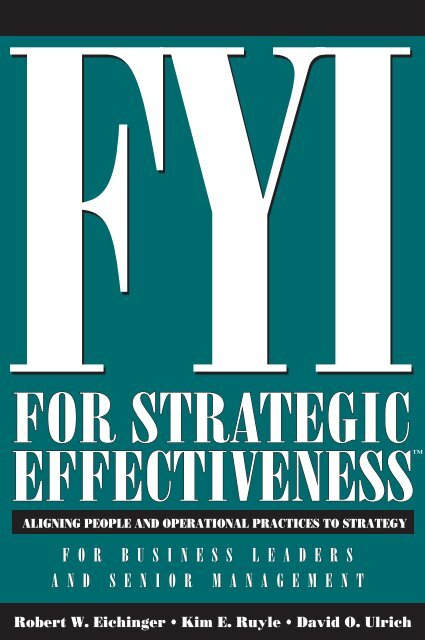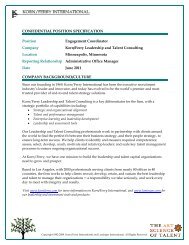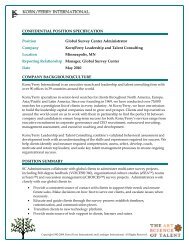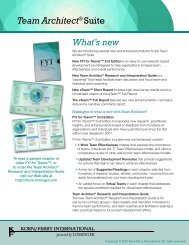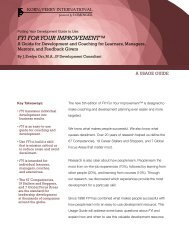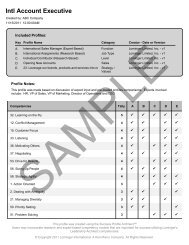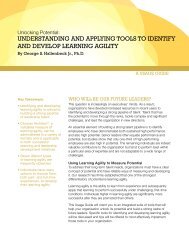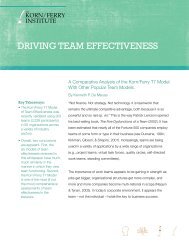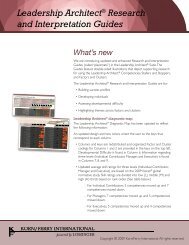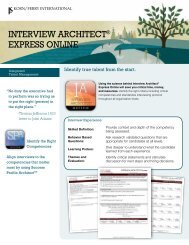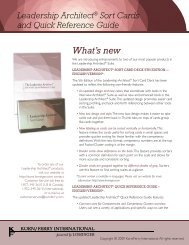for strategic effectivenessfor strategic effectiveness - Lominger
for strategic effectivenessfor strategic effectiveness - Lominger
for strategic effectivenessfor strategic effectiveness - Lominger
You also want an ePaper? Increase the reach of your titles
YUMPU automatically turns print PDFs into web optimized ePapers that Google loves.
FOR STRATEGICEFFECTIVENESSALIGNING PEOPLE AND OPERATIONAL PRACTICES TO STRATEGYF O R B U S I N E S S L E A D E R SA N D S E N I O R M A N A G E M E N TRobert W. Eichinger • Kim E. Ruyle • David O. Ulrich
FYIf o r STRATEGICEFFECTIVENESS Aligning Peopleand Operational Practicesto StrategyROBERT W. EICHINGERKIM E. RUYLEDAVID O. ULRICH
FYI FOR STRATEGIC EFFECTIVENESS Important Notice:© COPYRIGHT 2007<strong>Lominger</strong> International: A Korn/Ferry Company.ALL RIGHTS RESERVED.FYI For STRATEGIC EFFECTIVENESSFirst Printing—February 2007 (07.1a)No part of this work may be copied or transferred to any otherexpression or <strong>for</strong>m without a license from<strong>Lominger</strong> International: A Korn/Ferry CompanyTel. 952-345-3610 • Fax. 952-345-3601 • www.lominger.comThe LEADERSHIP ARCHITECT ® is the exclusive registered trademark of<strong>Lominger</strong> International: A Korn/Ferry CompanyISBN 1-933578-06-8<strong>Lominger</strong> reorder part number 21032Copyright © 2007 <strong>Lominger</strong> International: A Korn/Ferry Company. All rights reserved.
Dimension II: St r at e g y Ex e c u t i o nCl u s t e r D: Al i g n i n g w i t h St r at e g ySet your expectations high; find men and women whose integrityand values you respect; get their agreement on a course of action;and give them your ultimate trust.John Akers – Former Chairman, IBMComing together is a beginning. Keeping together is progress.Working together is success.Henry Ford – Founder, Ford Motor CompanyThe SignpostIt’s not enough to create a great competitive strategy. You need alignment.Everyone needs to be aligned. People must understand and share a common viewof the future. They must share commitment to the <strong>strategic</strong> goals. Everything needsto be aligned. Processes, goals, rewards, communication, policies—everythingaligned. A small team pulling in the same direction will beat a larger team working atcross-purposes every time.Items4. Continually shape the organization’s structure and work flows to meet thechanges and challenges of our marketplace24. Apply total work systems (e.g., TQM/ISO/Six Sigma) where needed44. Efficiently and effectively communicate our strategy to all employees64. Align people policies, practices, and programs to support our business strategy82. Identify the management and leadership competencies that our strategy requiresUnskilled• Can’t craft a compelling vision• Communicates poorly• Fails to set appropriate goals• Doesn’t reward the right things• Is unable to design effective processes• Is unwilling or unable to change, to adapt• Lacks clarity in adopting policies and procedures• Does not hold people accountableDimension II: Strategy Execution D: Cluster Aligning ### with Strategy19Copyright © 2007 <strong>Lominger</strong> International: A Korn/Ferry Company. All rights reserved.
Cl u s t e r D: Al i g n i n g w i t h St r at e g ySkilled• Communicates a clear, compelling vision• Sincerely believes in and is passionate about the strategy• Provides timely and relevant in<strong>for</strong>mation to all who need it• Sets aggressive goals that cascade down through the organization• Has a process orientation; can effectively engineer business processes• Has an eye <strong>for</strong> talent and selects the very best people <strong>for</strong> the role• Possesses clarity of purpose and focuses resources and energy appropriately• Drives the message about competitive strategy to every corner of theorganization• Rewards the behaviors that support the strategyD: Aligning with StrategyDimension II: Strategy ExecutionSome Causes• Fuzzy <strong>strategic</strong> vision• Dysfunctional culture• Lack of process discipline• Mixed messages• Poor listening• Actions don’t match message• Lacking perspective• Inattentive to details, can’t execute• Conflict avoidance• Rigid, unwilling or unable to adaptThe Ten LEADERSHIP ARCHITECT ® Competencies MostAssociated with This Cluster (in order of connectedness)51. Problem Solving52. Process Management50. Priority Setting2. Dealing with Ambiguity47. Planning58. Strategic Agility5. Business Acumen46. Perspective63. Total Work Systems (e.g., TQM/ISO/Six Sigma)65. Managing Vision and Purpose20Copyright © 2007 <strong>Lominger</strong> International: A Korn/Ferry Company. All rights reserved.
Cl u s t e r D: Al i g n i n g w i t h St r at e g yThe MapEven the best strategies will fail if they are not communicated and executed. Manystudies have shown that it is the organizations that have a common mind-set that winmore consistently. A common mind-set means everyone in the organization knowswhat the strategy is and knows what tactics and plans to follow. Every employeeshould be able to clearly explain the strategy in a couple of sentences. They should beable to explain how they contribute to the strategy. When everyone can do that, you’llhave achieved a common mind-set; you’ll have reduced friction in your processes andincreased the efficiency of decision making, resource allocation, and initiatives. Oncea common mind-set is established, the rest depends on clear leadership and cleanexecution. Alignment is the operative word. All of the things the organization doesneed to align with the strategy. Policies should result in aligned behaviors. Rewardsshould support aligned behaviors. Processes and organizational structure need to bealigned. Deployment of leaders and teams needs to be aligned with and guided bythe strategy. Total alignment leads to laser-like execution. Not a second wasted. Not apenny wasted. Mission accomplished.Some Remedies1. Focus. Think laser—photons in a coherent beam. They’re aligned. They’re ofone wavelength. They’re focused. Bring a laser-like focus to everything. Yourprocesses. Your organizational structure. Policies. Procedures. Compensationand rewards. Hiring. Per<strong>for</strong>mance management. Succession planning. Decisionmaking. Communication. Everything focused on achieving your competitivebusiness strategy.2. Communicate. Communicate. Communicate. A common mind-set is createdby communication and dialog. Think of it as a marketing campaign. If there wassomething very important <strong>for</strong> your customers to know, what would you do? Dothe same with the strategy. Engage marketing professionals inside or outside theorganization to create a marketing campaign complete with themes, slogans, ads,colors, and a communication strategy which includes multiple communicationmethods and channels. The dialog is <strong>for</strong> both understanding and ownership. Helppeople own the vision. Craft the message so it’s crystal clear and easily understoodby everyone. Embrace it passionately. Then, assuming you have the rightpeople in the right roles, it’s all about execution.Dimension II: Strategy Execution D: Aligning with Strategy3. Align with customers. Design from the outside in. Start with the delightedcustomer. Design the distribution and delivery chain backwards, asking whateach process step should look like to result in a delighted customer. What will theproduct look like? The service? What’s the best way to get the order? The bestway to deliver? Always think first of the customer.21Copyright © 2007 <strong>Lominger</strong> International: A Korn/Ferry Company. All rights reserved.
Cl u s t e r D: Al i g n i n g w i t h St r at e g yD: Aligning with StrategyDimension II: Strategy Execution4. Align leadership. Every strategy has a leadership brand that goes with it. Everystrategy, given a particular industry context, location, and market, has a set ofrequired leadership skills and competencies. A strategy that calls <strong>for</strong> speed indecision making needs speedy managers and executives. A strategy that calls<strong>for</strong> key account intimacy requires managers and executives that are good at<strong>for</strong>ming lasting relationships. A strategy that calls <strong>for</strong> producing commodityproducts in a cost-conscious market needs leaders who are efficient managers.For each element of the strategy, consider what kind of a leader or manager willbest be able to execute this element. Once you have the competencies, evaluatethe current managers and executives and locate the fits and gaps. For the gaps,decide whether you will close the gap developmentally, find a better fit inside, orgo outside to get the best fit.5. Align goals. Common sense, right? Your top-level business objectives must alignwith your <strong>strategic</strong> intent. It starts at the top and cascades down to the individualemployee. Every individual contributor should have goals aligned with and insupport of the team. The team goals should be aligned with and in support ofthe department, and so <strong>for</strong>th. From the top of the organization to the bottom,establish goals so people and groups are aligned with the strategy.6. Align measurement. Goals don’t mean much if results aren’t measured.Rigorously measure. Measure what matters to your strategy. Measurementgets people’s attention. Measure inputs. Measure outputs. Measure processes.Use the results of measurement. Analyze, act, correct, change, improve. Makemeasurement and improvement part of everyone’s job. Give them the toolsand language and skills to measure effectively and to take corrective action <strong>for</strong>improvement.7. Align culture. Culture is the way things are done in the organization, the sum ofthe habitual behaviors of the individuals. How do you hire? Promote? Celebrate?Make decisions? Reward? Communicate? Every organization has a certain style thatmay be more or less well defined. The style influences behavior. What behaviorsdo you need to support your strategy? What style will promote those behaviors?Choose a style, a culture that is aligned with your strategy, then adopt policiesand procedures and an organizational structure that reflect that style. Model thebehaviors you want emulated throughout the organization. Put structures in placeto promote that culture. If you want a culture that drives decision making down tothe lowest level, you need to have policies and procedures that empower frontlineworkers. That needs to become the norm. Talk it. Walk it. Reward it. Culture is apowerful influencer of organizational per<strong>for</strong>mance. Make it work <strong>for</strong> you.8. Give lots of feedback. Feedback is an essential component of per<strong>for</strong>mance. Getemployees aligned by communicating, goal setting, measurement, and also byincluding regular feedback on their per<strong>for</strong>mance. Effective feedback is specific,22Copyright © 2007 <strong>Lominger</strong> International: A Korn/Ferry Company. All rights reserved.
Cl u s t e r D: Al i g n i n g w i t h St r at e g ydirect, and delivered in a timely and genuine way by the manager or customer.Make your environment a feedback-rich environment, and supplement thefeedback with coaching and mentoring to encourage and guide development inthe core competencies.9. Align rewards. Goals, measurement, feedback—all are essential components ofaligned per<strong>for</strong>mance. Those are the things that get per<strong>for</strong>mance kick-started. Butit is meaningful rewards and consequences that sustain the per<strong>for</strong>mance over thelong haul. Align your reward system to your strategies to rein<strong>for</strong>ce the behaviors,accomplishments, and skill development that will drive competitive advantageand success. The per<strong>for</strong>mance picture is not complete until you’ve aligned therewards with your strategy.10. Align with best practices. There are established and proven methods toimprove business practices. Practices like Total Quality Management, Six Sigma,Lean Manufacturing, and Business Process Reengineering are all used to improvequality, productivity, timeliness, and costs associated with processes. Alignmentwith customers and strategy is inherently built into these practices. Consider thesepractices and adopt what best fits your organization. Pick something and getstarted.Dimension II: Strategy Execution D: Cluster Aligning ### with Strategy23Copyright © 2007 <strong>Lominger</strong> International: A Korn/Ferry Company. All rights reserved.
Cl u s t e r D: Al i g n i n g w i t h St r at e g yD: Aligning with StrategyDimension II: Strategy ExecutionSuggested ReadingsAbraham, G. A. (2006). Strategic Alignment. Leadership Excellence, 23(8), 12.Allio, M. K. (2005). A short, practical guide to implementing strategy. Journal ofBusiness Strategy, 26(4), 12-21.Aquila, A. J. (2005). Align compensation to your firm’s <strong>strategic</strong> goals. AccountingToday, 19(14), 9-23.Bossidy, L., & Charan, R. (2002). Execution: The discipline of getting things done.New York, NY: Crown Business.Brad<strong>for</strong>d, R. (2002). Strategic alignment. Executive Excellence, 19(1), 8-9.Goodstein, L. D., Nolan, T. M., & Pfeiffer, J. W. (1993). Applied <strong>strategic</strong> planning:A comprehensive guide. New York: McGraw-Hill, Inc.Gupta, A. K. (1984). Contingency linkages between strategy and general managercharacteristics: A conceptual examination. Academy of Management Review, 9,399-412.Gupta, A. K., & Govindarajan, V. (1984). Build, hold, harvest: Converting <strong>strategic</strong>intentions into reality. Journal of Business Strategy, 4(3), 34-47.Kaplan, R. S., & Norton, D. P. (2001). Building a strategy-focused organization. IveyBusiness Journal, 65(5), 12-19.Kaplan, R. S., & Norton, D. P. (2006, March). How to implement a new strategywithout disrupting your organization. Harvard Business Review, 84(3), 100-109.Kerr, J. L., & Jackofsky, E. F. (1989). Aligning managers with strategies:Management development versus selection. Strategic Management Journal, 10,157-170.Lawler, E. (1996). From the ground up: Six principles <strong>for</strong> building the new logiccorporation. San Francisco, CA: Jossey-Bass.Steel, R. (1991). From paper to practice: Implementing the corporate <strong>strategic</strong>plan. Business Quarterly, 55(3), 119-124.Williams, S. L. (2002). Strategic planning and organizational values: Links toalignment. Human Resource Development International, 5(2), 217-233.24Copyright © 2007 <strong>Lominger</strong> International: A Korn/Ferry Company. All rights reserved.


